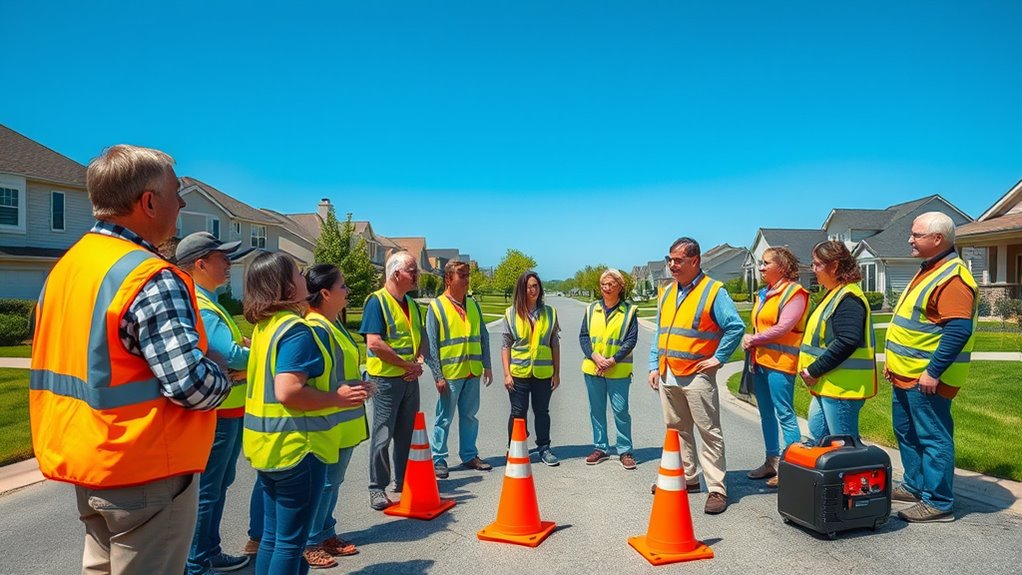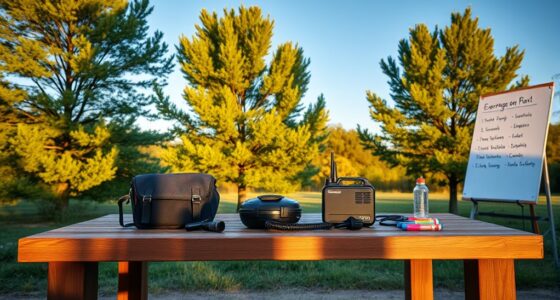To coordinate neighborhood outage drills effectively, start by developing a clear plan that assigns roles and outlines actions during a power outage. Engage local authorities and utility companies for guidance and support. Schedule regular drills to keep everyone prepared, testing communication methods and emergency procedures. Involve residents of all ages, especially vulnerable neighbors, and gather feedback to improve your plan. Continuing with this process helps turn uncertainty into confidence and strengthens your community’s resilience.
Key Takeaways
- Develop a detailed outage plan involving residents, authorities, and utility companies to ensure coordinated response efforts.
- Schedule regular drills to simulate outages, test communication methods, and identify response gaps.
- Assign specific roles and responsibilities to residents, including checking on vulnerable neighbors.
- Collaborate with utility providers to understand restoration procedures and incorporate their guidance into drills.
- Collect feedback after each drill to refine emergency plans, improve coordination, and enhance community resilience.

Have you ever wondered how prepared your neighborhood is for a power outage? It’s a question that highlights the importance of understanding the strength and resilience of your local power grid. A well-coordinated neighborhood outage drill can reveal gaps in emergency preparedness, ensuring that everyone knows what to do when the lights go out unexpectedly. When planning these drills, it’s essential to involve the entire community, from residents to local authorities, so that everyone is on the same page and ready to respond effectively. This coordination not only tests the reliability of your power grid but also fosters a sense of teamwork and shared responsibility among neighbors.
To start, you need a solid plan that outlines specific roles and actions during an outage. This plan should consider common challenges, such as communication breakdowns or limited access to emergency supplies. Make sure to include steps for checking on vulnerable neighbors—elderly residents or those with medical equipment dependent on electricity. By simulating a blackout, you can identify weaknesses in your community’s emergency preparedness, such as inadequate backup power sources or poor communication channels. It’s also a good opportunity to test emergency communication methods, like community alert systems or neighborhood WhatsApp groups, which can be crucial during real outages.
Develop a detailed outage plan, including communication and vulnerable neighbor support.
Involving local authorities or utility companies can greatly enhance the effectiveness of your drill. They can provide insights into the stability of the power grid and offer guidance on how to respond to different scenarios. During the drill, coordinate with these entities to simulate power restoration efforts, so residents understand what to expect and how long recovery might take. This not only prepares everyone mentally but also builds trust in the system’s ability to bounce back after disruptions. Remember, the goal isn’t just to simulate a blackout but to strengthen your collective emergency preparedness so that your neighborhood can handle actual outages with confidence and resilience.
Finally, after each drill, gather feedback from participants. Discuss what worked and what didn’t, and update your emergency plan accordingly. Regular drills keep everyone alert and prepared, making outages less disruptive and more manageable. By actively participating in coordinated neighborhood outage drills, you help ensure that your community’s power grid remains resilient and that everyone knows how to stay safe and connected during challenging moments. This proactive approach is the key to turning uncertainty into preparedness, giving you peace of mind no matter when the next outage occurs. Recognizing the importance of thorough due diligence can help you better understand potential vulnerabilities and enhance your community’s readiness.
Frequently Asked Questions
How Do I Volunteer for Neighborhood Outage Drills?
You can volunteer for neighborhood outage drills by reaching out to your local community center or emergency preparedness organization. They often seek volunteers to promote community engagement and improve emergency preparedness. Sign up online or attend a meeting to express your interest. Your participation helps make certain everyone is ready for outages, making your neighborhood more resilient. Getting involved now fortifies your community’s ability to respond effectively during real emergencies.
What Safety Precautions Are Recommended During Drills?
During drills, you should prioritize safety by wearing appropriate safety gear like gloves and reflective vests. Make sure to establish clear emergency communication protocols, such as using walkie-talkies or cell phones, to stay in contact with others. Always stay alert and follow the instructions provided by coordinators. Avoid risky behaviors and keep the area clear of hazards to guarantee everyone’s safety during the exercise.
How Can Residents Provide Feedback on Outage Drills?
Like sending a carrier pigeon in the age of smartphones, providing community feedback on outage drills is simple. You can share your thoughts through survey methods online or via paper forms. Make sure to be honest and specific about what worked or didn’t. Your input helps improve future drills, ensuring everyone’s safety. Don’t hesitate—your feedback is crucial for creating a more resilient neighborhood during power outages.
Are There Incentives for Participating in Outage Drills?
Yes, there are incentives for participating in outage drills. Community engagement is encouraged through incentive programs that reward residents for their involvement. These programs might include discounts on utility bills, gift cards, or recognition in community events. Participating not only helps improve the neighborhood’s preparedness but also offers you tangible rewards. By engaging actively, you contribute to a safer community while enjoying the benefits that come with being part of these incentive programs.
How Are Outage Drill Locations Selected Within Neighborhoods?
You select outage drill locations within neighborhoods based on community mapping and location criteria. These criteria include areas with high population density, vulnerable populations, and critical infrastructure. Your goal is to guarantee all residents are prepared, so you prioritize easily accessible sites that represent diverse community segments. By analyzing this data, you make strategic choices that maximize participation and effectiveness, helping everyone stay safe during outages.
Conclusion
By participating in neighborhood outage drills, you help create a more resilient community. These exercises gently prepare us for unexpected moments, turning potential surprises into smooth, coordinated responses. When everyone plays their part, we’re all better equipped to handle life’s little hiccups. So, embrace these drills as a chance to strengthen bonds and build confidence. After all, a well-prepared neighborhood is like a warm, steady heartbeat—ready to weather any storm together.








